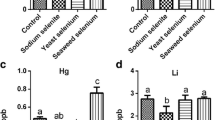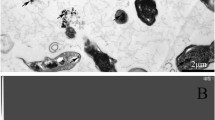Abstract
Selenium has both nutritional function and toxicity according to its concentration and species. To counteract the toxicity of selenium, scutellarin was investigated. Wistar rats were supplemented with 40 µg Se/kg/d as sodium selenite, 40 µg Se/kg/d with 20 mg/kg/d scutellarin, and 20 mg/kg/d scutellarin, respectively, for 15 d. The mRNA levels and activities of glutathione peroxidase (GSH-Px) and thioredoxin reductase (TR), and the malondialdehyde (MDA) contents were measured. Reactive oxygen species (ROS) were detected by chemiluminescence assay, and tissue conformation was investigated by histological study. The results showed significant decreases of mRNA levels and activities of GSH-Px and TR and a significant increase of MDA content in livers of the Se-treated rats (p<0.05, compared with the control). Supplementation of scutellarin to the Se-treated group significantly inhibited the decreases of mRNA levels and activities, and the increase of MDA content (p<0.05, compared with the Setreated group). Meanwhile, scutellarin-scavenged ROS generated in the mixture of sodium selenite, reduced glutathione, and oxygen. Liver injury was displayed in slices exposed to selenium at the present dose. The groups treated with both selenium and scutellarin or only scutellarin did not show significant tissue damage. Thus, scutellarin had an antagonistic effect against the toxicity of selenium.
Similar content being viewed by others
References
G. F. Kramer and B. N. Ames, Mechanisms of mutagenicity and toxicity of sodium selenite (Na2SeO3) in Salmonella typhimurium, Mutat. Res. 201, 169–180 (1988).
Y. Seko, Y. Saito, J. Kitahara, et al., Active oxygen generation by the reaction of selenite with reduced glutathione in vitro, in Selenium in Biology and Medicine, A. Wendel, ed., Springer-Verlag, Berlin, pp. 70–73 (1989).
J. E. Spallholz, On the nature of selenium toxicity and carcinostatic activity, Free Radical Biol. Med. 17, 45–64 (1994).
H. Xu, Z. Feng, and C. Yi, Free radical mechanisms of the toxicity of selenium compounds, Huzahong Lonjoong Daxue Xuebao 19, 13–19 (1991).
L. Yan and J. E. Spallholz, Generation of reactive oxygen species from the reaction of selenium compounds with thiols and mammary tumor cells, Biochem. Pharmacol. 45, 429–437 (1993).
K. B. Hadley and R. A. Sunde, Selenium regulation of thioredoxin reductase activity and mRNA levels in rat liver, J. Nutr. Biochem. 12, 693–702 (2001).
L. Gan, Q. Liu, H. B. Xu, et al., Effects of selenium overexposure on glutathione peroxidase and thioredoxin reductase gene expressions and activities, Biol. Trace Element Res. in press.
J. V. Formica and W. Regelson, Review of the biology of quercetin and related bioflavonoids, Food Chem. Toxicol. 33, 1061–1080 (1995).
A. Mora, M. Paya, J. I. Rios, et al., Structure activity relationships of polymethoxyflavones and other flavonoids as inhibitors of non-enzymatic lipid peroxidation, Biochem. Pharmacol. 40, 793–797 (1990).
C.G.M. Heijnen, G.R.M.M. Haenen, F.A.A. van Acker, et al., Flavonoids as peroxynitrite scavengers: the role of the hydroxyl groups, Toxicol. In Vitro 15, 4–6 (2001).
A. Holmgren and M. Bjornstdt, Thioredoxin and thioredoxin reductase, Methods Enzymol. 252, 199–208 (1995).
K. E. Hill, G. W. McCollum, M. E. Boeglin, et al., Thioredoxin reductase activity is decreased by selenium deficiency, Biochem. Biophys. Res. Commun. 234, 293–295 (1997).
L. Yan and J. E. Spallholz, Generation of reactive oxygen species from the reaction of selenium compounds with thiols and mammary tumor cells, Biochem. Pharmacol. 45, 429–437 (1993).
D. L. Hatfield, ed., Selenium: Its Molecular Biology and Role in Human Health, Kluwer Academic, Boston (2001).
K. B. Hadley and R. A. Sunde, Selenium regulation of thiredoxin reductase activity and mRNA levels in rat liver, J. Nutr. Biochem. 12, 693–702 (2001).
J. Qu, Y. M. Wang, G. A. Luo, et al., Determination of scutellarin by LC/MS//MS, Acta Pharm. Sin. 35(2), 139–141 (2000).
N. C. Cook and S. Samman, Flavonoids—chemistry, metabolism, cardioprotective effects, and dietary sources, Nutr. Biochem. 7, 66–75 (1996).
E. Middleton, Jr. and C. Kandaswami, The impact of plant flavonoids on mammalian biology: Implications for immunity, inflammation and cancer, in The Flavonoids: Advances in Research Since 1986, J. B. Harborne, ed., Chapman & Hall, London, pp. 619–652 (1993).
A. K. Ratty and N. P. Das, Effects of flavonoids on nonenzymic lipid peroxidation: structure-activity relationship, Biochem. Med. Metab. Biol. 39, 69–79 (1988).
Y. Hanasaki, S. Ogawa, and S. Fukui, The correlation between active oxygens scavenging and antioxidative effects of flavonoids, Free Radical Biol. Med. 16, 845–850 (1994).
V. D. Bokkenheuser and J. Winter, Hydrolysis of flavonoids by human bacteria, in Plant Flavonoids in Biology and Medicine II: Biochemical, Cellular, and Medical Properties, Liss, New York, pp. 143–145 (1988).
Author information
Authors and Affiliations
Rights and permissions
About this article
Cite this article
Abdalla Eltayeb, A., Liu, Q., Gan, L. et al. Antagonistic effect of scutellarin on the toxicity of selenium in rat livers. Biol Trace Elem Res 98, 253–264 (2004). https://doi.org/10.1385/BTER:98:3:253
Received:
Accepted:
Issue Date:
DOI: https://doi.org/10.1385/BTER:98:3:253




